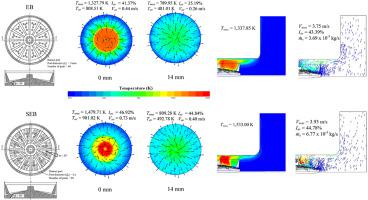Case Studies in Thermal Engineering ( IF 6.4 ) Pub Date : 2021-09-20 , DOI: 10.1016/j.csite.2021.101466 Anirut Matthujak , Mana Wichangarm , Thanarath Sriveerakul , Sedthawatt Sucharitpwatskul , Sutthisak Phongthanapanich

|
This study investigated a swirling flow in household LPG burners and its effects on thermal efficiency enhancement. Modified from a typical energy-saving burner (EB), a newly invented swirling flame energy-saving burner (SEB) was built and tested both experimentally and numerically. Computational Fluid Dynamics (CFD) simulations were employed to investigate the flow inside the SEB with an inclined angle of 50° and a swirl angle of 15° as well as the flow inside the EB. The computational results were used to calculate the heat conversion efficiencies, which were then compared to the experimental values obtained from the water boiling test (DIN EN 203-2 standard). Additionally, the simulations provide data on the combustion temperature, the turbulence intensity, and the secondary air flow rate. This detailed information clearly confirms that the swirling flow does increase the maximum combustion temperature and the net heat flux into the vessel, directly enhancing the heat conversion efficiency and thus increasing the thermal efficiency. According to the simulations, the heat conversion efficiency of the SEB is around 3.44% greater than that of the EB, while the experiments show that the SEB gives approximately 2.75% higher thermal efficiency than that of the EB. The future expectation is that the heat conversion efficiency can be used to predict the increase in thermal efficiency. With this method, the commercial design of the energy-saving burner can be improved.
中文翻译:

旋流对LPG节能燃烧器热效率提高影响的数值研究
本研究调查了家用液化石油气燃烧器中的旋流及其对热效率提高的影响。在典型的节能燃烧器(EB)的基础上,研制了一种新发明的旋流式节能燃烧器(SEB),并进行了实验和数值试验。采用计算流体动力学 (CFD) 模拟来研究倾斜角为 50° 和涡流角为 15° 的 SEB 内部的流动以及 EB 内部的流动。计算结果用于计算热转化效率,然后将其与从水沸腾测试(DIN EN 203-2 标准)获得的实验值进行比较。此外,模拟还提供了有关燃烧温度、湍流强度和二次空气流速的数据。这些详细信息清楚地证实,旋流确实提高了最高燃烧温度和进入容器的净热通量,直接提高了热转换效率,从而提高了热效率。根据模拟,SEB 的热转换效率比 EB 高约 3.44%,而实验表明 SEB 的热效率比 EB 高约 2.75%。未来的期望是热转换效率可以用来预测热效率的增加。通过这种方法,可以提高节能燃烧器的商业设计。直接提高热转换效率,从而提高热效率。根据模拟,SEB 的热转换效率比 EB 高约 3.44%,而实验表明 SEB 的热效率比 EB 高约 2.75%。未来的期望是热转换效率可以用来预测热效率的增加。通过这种方法,可以提高节能燃烧器的商业设计。直接提高热转换效率,从而提高热效率。根据模拟,SEB 的热转换效率比 EB 高约 3.44%,而实验表明 SEB 的热效率比 EB 高约 2.75%。未来的期望是热转换效率可以用来预测热效率的增加。通过这种方法,可以提高节能燃烧器的商业设计。未来的期望是热转换效率可以用来预测热效率的增加。通过这种方法,可以提高节能燃烧器的商业设计。未来的期望是热转换效率可以用来预测热效率的增加。通过这种方法,可以提高节能燃烧器的商业设计。











































 京公网安备 11010802027423号
京公网安备 11010802027423号